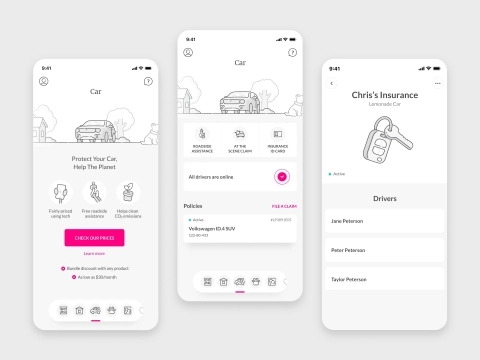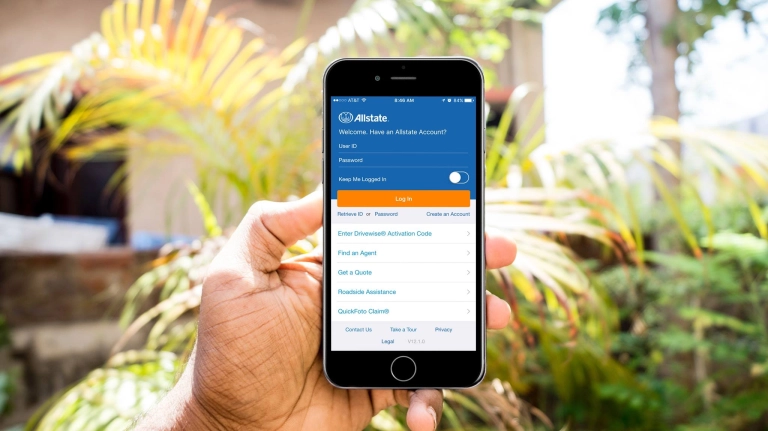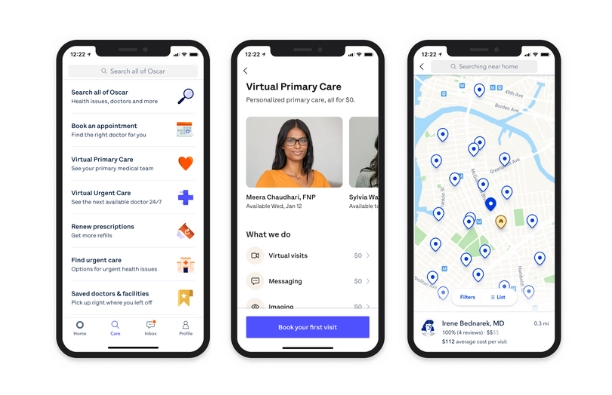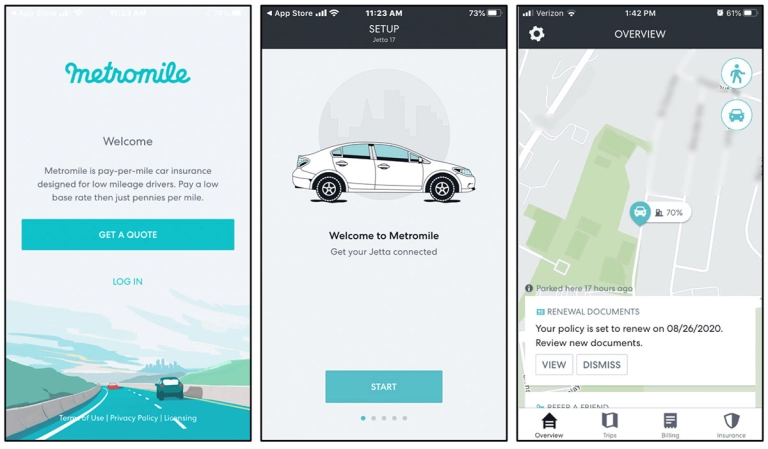If you are in the insurance business in 2024, the solution to increasing operational efficiency and improving revenue is insurance mobile app development. Customers use apps for everything as they look for convenient and seamless experiences, and insurance is the next horizon among mobile apps.
The global insurance market is expected to grow at a CAGR of 52% from 2021 to 2030 and reach a whopping USD 166.7 billion by 2030, which showcases immense potential. While many insurance apps are already on the market, there are still plenty of opportunities for competitive advantage.
In this article, we will overview everything necessary for insurance app development, from must-have features and case studies to benefits of mobile apps, the use of different technologies, and best practices for development. Let's proceed.
Must-have insurance app features
During the insurance application development, you will encounter countless variations of potential features to add to your custom insurance mobile app. But what are the features that make sense for most apps? Let's look at them.
Profile
A profile is a primary screen with information about the insured object or individual. It includes name, address, and other personal details. This feature also sometimes goes under the name admin panel. You will find the basic information about the subject of insurance on this page.
Policy management
Users should be able to view details of their policies and browse new policies. For convenience, the search should be generated based on parameters and specific keywords.
Additionally, the app should allow users to renew their policies or purchase new ones directly through the app. Moreover, this feature could be enhanced by recommending policies based on the customer's search history and previous purchases.
Available policies should come with quotes so that customers can access the price. In general, any information about policies that might be helpful must be easy to access.
Claims filing and tracking
This is one of the insurance app features that customers use most often. It enables users to file claims directly through the app and track the claim's progress.
App developers should provide a straightforward form for claim submission and a tracking feature so users can monitor the status of their claims. There are no successful insurance apps without the seamless capacity to file claims.
This feature should enable users to submit claims with ease , including photos and documents. Ideally, all features of claim filing should fit into one page.
Document upload and management
Directly related to claim filing, this feature should allow users to upload and manage necessary documents accompanying their policies or claims, such as identification, policy documents, and evidence for claims.
Payment gateway
The features for insurance mobile apps should integrate a secure on-the-spot payment system for payments and purchasing new policies without the need to turn to third-party banking applications.
The apps must support multiple payment methods to accommodate different user preferences. The fewer tabs this feature requires, the better it is for the customer experience. Automatic payment options would be the best option to consider.
Along with that, payment history should also be accessible within this feature, as well as one-click payment.
Customer support and chatbots
Apps should offer live customer support (ideally, 24/7) and integrate chatbots for quick assistance.
Other related features as a part of customer support include FAQs, email support, and contact information for speaking with an agent directly through in-app calls in situations when chatbots do not cut it.
Notifications and alerts
The app should be able to notify users about policy renewals, payment due dates, claim updates, and other important information related to their insurance policies. The most common method for this function is push notifications.
Educational resources
This feature can provide users with resources to understand their insurance policies better, including articles, videos, and tips on insurance products and financial planning.
Feedback and review system
It's important for insurance apps to have a feedback system for users to share their experience, which can help improve the app and customer service.
Multi-language support
Offering the app in multiple languages means catering to a diverse user base and enhancing user experience for non-English speakers.
Create successful mobile apps and unique user experiences with Binariks' experts
How features change depending on the type
Aside from the properties you would expect to have in any other app, insurance apps require specific features depending on their type.
For example, health insurance apps may need integration with wearable devices and car insurance apps – with roadside assistance apps, etc.
So, let's overview the specific features of applications for health, car, life, property, and travel insurance.
Health insurance apps
- Telehealth services
Telehealth features provide access to medical consultations through video calls , reducing the need for in-person visits.
- Health tracking
The app integrates with wearable devices to monitor health metrics like heart rate, steps, and sleep quality, which can be used for personalized health programs and insurance discounts.
- Prescription management
This feature allows users to manage their prescriptions, including reminders to take medications and options to renew prescriptions online.
Some health insurance apps can allow you to schedule appointments with a preferred or available doctor and an option to chat with them. Also, health insurance apps often feature an option to compare multiple clinics and pharmacies' prices and reviews.
Car insurance apps
- Telematics and driving behavior monitoring
Auto insurance apps utilize the smartphone's sensors or a separate device installed in the vehicle to monitor driving behavior. The gathered information influences insurance premiums based on safe driving practices.
- Roadside assistance
Apps offer quick access to roadside assistance services in an emergency, such as a flat tire or breakdown.
- Digital ID cards and documents
Having ID cards in-app provides instant digital proof of insurance. For car insurance apps, it is also important to instantly upload photos.
- Claims submission and tracking
What makes claim submissions for car apps different is that they should be filed on the spot right after the accident. With the claim, drivers should get a cost estimate for the future repair.
- Reminders for upcoming vehicle repair and maintenance
This is another type of push notification important for auto insurance to avoid accidents due to vehicle malfunctioning.
- Geolocation to identify the place of accident
Life insurance apps
- Health and wellness incentives
Some life insurance apps include features that reward users for healthy behaviors, similar to health insurance apps, offering discounts on premium costs.
- Estate planning resources
Life insurance apps provide resources and tools for estate planning, including will creation and advice on setting up trusts.
Property insurance apps
- Home inventory management
This feature helps users create and manage an inventory of their home contents, which is helpful in the event of a claim.
- Preventative maintenance alerts
Based on the principle of a push notification, this feature can send alerts for potential property maintenance issues before they become serious based on weather data or other risk factors.
- Smart home integration
Some property insurance apps integrate with smart home devices to monitor for risks like water leaks or unauthorized entry, potentially preventing incidents before they occur.
Travel insurance apps
- Emergency services locator
Some apps include features to help users find nearby medical facilities, embassies, or law enforcement agencies in case of an emergency.
- Travel assistance services
Beyond traditional insurance coverage, apps may offer pre-trip information (e.g., visa requirements, safety advisories), concierge services, and assistance in case of lost passports or legal troubles while abroad.
- Currency converter and expense tracking
Some apps include additional tools to help travelers manage their finances abroad, such as currency conversion features and expense tracking.
- Customizable coverage options
Travel insurance apps allow users to customize their coverage based on their travel activities (e.g., adventure sports, business travel) and destination specifics, ensuring they have the right level of protection.
Insurance app examples
Lemonade

Founded in New York in 2015, Lemonade is a full-spectrum insurance app offering insurance to renters, homeowners, and pets. It also provides life insurance.
Lemonade stands out for its Giveback program, where unused premiums are donated to charities chosen by policyholders. Moreover, it offers highly personalized insurance plans for its customers and has a 24/7 insurance plan. Customers can easily modify their insurance plans instantly using the app's intuitive UI/UX design.
GEICO Mobile

GEICO Mobile is the most popular auto insurance app in the United States. The app has all of the must-have insurance app features. It features specific to the auto insurance apps: digital ID cards, roadside assistance, and even car rental features or gas station locators.
The Vehicle Care feature helps users keep track of their car's service history, recalls, and maintenance reminders. There is also Geico Explore, an augmented reality feature that allows users to locate their parked cars and find nearby amenities like gas stations and restaurants.
Allstate Mobile

Allstate offers various insurance services, including vehicle, property, life, business, and even identity protection. Some of the most innovative functions of this insurance web app are related to car insurance.
For instance, there are Drivewise, a telematics program that rewards safe driving, and QuickFoto Claim, which allows users to upload photos for faster claim processing. Beyond this, Allstate also has Allstate Digital Locker®, which offers a convenient way to inventory personal property for claims or record keeping.
Overall, Allstate is a great example of a custom insurance mobile app that supports all insurance types with specific features without compromising quality.
Oscar Health

Oscar Health focuses on health insurance with a user-friendly interface that includes a searchable database of health care providers, digital ID cards, and direct scheduling of appointments without referrals or needing to call the doctor's office. It also offers a step-tracking feature that rewards users for reaching health and fitness goals.
The app has a doctor-on-the-call feature, which offers 24/7 access to virtual doctor visits at no extra cost. Additionally, the app has a feature that consolidates all health actions, lab results, and doctor visits in one place.
Metromile

Metromile is a Californian pay-per-mile car insurance company with an excellent app that supports customizable coverage. One of the best features of this app is pay-per-mile insurance, which charges users based on the actual miles they drive, potentially saving low-mileage drivers money.
Besides, Metromile offers car health monitoring, which provides diagnostics and alerts for car issues, helping prevent bigger problems. The trip optimization feature provides insights into trips and driving trends, including fuel usage and time spent on the road, and theft recovery uses the app's telematics device to help locate a stolen vehicle.
Benefits and limitations of insurance applications
Insurance applications are convenient for customers and insurance agents, and they generally bring many benefits. However, insurance apps will not help with some aspects of the insurance business. Let's explore what these apps can and cannot do.
Benefits of insurance apps
- Insurance apps speed up the communication between insurance companies and customers and make it more effective.
- Insurance apps automate basic tasks, which gives insurance agents time to focus on more complex challenges. They also give brokers time to search for new clients.
- One can advertise insurance apps in other mobile applications. In general, apps attract more clients. Engaging apps increases the number of customer interactions, enhancing loyalty.
- Apps use technologies like AI and ML, which allow them to process larger amounts of data faster. Mobile app development for insurance brokers also means better access to data for agents.
- Digital and remote communication channels with self-service are more convenient. There is no need to visit the insurance agency and fill out all that paperwork, as the customers can get personalized policies and 24/7 customer support from the comfort of their homes.
- Mobile apps simplify the claims submission process, allowing users to upload necessary documents and photos directly through the app and track the status of their claim processing.
- Apps allow for gathering detailed customer data, enabling personalized offers and services.
- Apps allow customers to gather feedback, which provides an excellent window into their pain points that standard insurance businesses just cannot collect.
- Mobile app development for insurance agents helps them be more efficient. With an app, they can track workflows, communicate with the clients, and access all the necessary data.
- Insurance companies can tap into a dynamic market beyond standard insurance by creating insurance apps. The insurtech market is expected to reach $10.14 billion by 2025 (Source ). For traditional businesses, entering this market is essential for future growth. Developing an insurance app can provide a competitive advantage.
Limitations of insurance apps
Most of the insurance app limitations have to do with the fact that many interactions on insurance require human expertise. The good news is that access to human expertise can help remove these limitations, and none of the issues are critical. Here are some of them:
- Apps cannot automatically handle complex claims like litigation, opioid utilization, or comorbidities. Handling such claims should involve brokers. The same goes for personalized advice and handling disputes.
- Although apps offer convenience, they may not always provide the depth of information or understanding that a face-to-face meeting or detailed conversation with an agent can offer, especially for clients with limited insurance knowledge.
- Users with limited access to technology or those who are not tech-savvy may find it challenging to use these apps effectively. Additionally, technical issues or limitations, like system failures, may hinder the experience of using these apps.
Embrace InsurTech innovation with custom software development
Adoption of modern technologies in insurance apps
App development for insurance businesses integrates all popular modern technologies, like AI/ML, IoT, and blockchain. Let's take a closer look at how this integration occurs.
AI and machine learning
Insurance companies use AI and machine learning to collect insurance data. They also speed up real-time policy pricing, purchase, and binding. For example, in the insurance app development process, you can use AI to create risk profiles based on individual behavior within minutes.
AI and machine learning also enable highly dynamic, usage-based insurance (UBI) products that adapt to an individual's behavior, which results in a more personalized user experience.
Machine and deep learning models help automate underwriting and claim processing. AI is also used to speed up verification processes and detect fraud.
Here are some examples of how AI and machine learning are used in insurance apps:
- Lemonade features an AI bot named "AI Jim" that handles claims and customer queries. The app also processes claims quickly , sometimes in just a few seconds, by analyzing data with machine learning algorithms to detect fraud and automate the claims process.
- Oscar Health utilizes AI and machine learning to personalize healthcare plans and improve customer service through its app. It offers telehealth services and allows customers to consult with doctors via video calls. The app also features a "Concierge" team, supported by AI, to assist customers with their health needs, from finding a doctor to understanding their health benefits.
- Machine learning algorithms analyze user data to offer personalized insurance policy recommendations across many apps.
Blockchain
The key function of blockchain in insurance mobile app development is to enable smart contracts to authorize payments instantly. This reduces the processing time of claims.
With blockchain, the insurance process is transparent and reliable to consumers, as it supports peer-to-peer (P2P) insurance models. Specific app implementations of blockchain are more internal and focused on improving the backend processes, such as claim settlements and risk management.
Synthetic data
Synthetic data stands for the information manufactured artificially based on algorithms rather than taken from real-life events. It is used as a way of training AI systems while maintaining data privacy.
It allows for data augmentation in AI and machine learning development. Synthetic data also facilitates explainable AI, ensuring models are understandable and their decisions can be explained.
Moreover, synthetic data enables secure and compliant data sharing within the insurance ecosystem, including agents, service providers, and reinsurers, without compromising the original data's integrity.
Most modern apps train their AI models based on synthetic data. Synthetic data is used to simulate various risk scenarios and to train models without exposing sensitive customer data.
IoT (Internet of Things)
Insurers may use IoT sensors and devices to collect data about health and driving habits from customers or collect data about the property.
Based on the collected data, insurers offer telematics programs to the customers, including personalized premiums based on safe driving practices or rewards for healthy habits like walking 10.000 steps daily.
IoT devices are used in homes to detect risks such as water leaks or unauthorized entry.
Many apps, including Metromile, offer pay-per-mile insurance. The app uses the Metromile Pulse, which plugs into the car's OBD-II port, to track driving behavior and mileage.
Cost to develop an insurance app
The cost to develop an insurance app varies greatly from $30.000 for a minimum viable product to $50.000 - $120.000 for a basic app with features for insurance mobile apps like claim processing and payment gateways to $300.000 for complex apps with complex features like chatbots, health trackers, and telematics.
You can end up at the lower end of these prices if you hire insurance app developers based in Eastern Europe or other regions outside the US and Western Europe.
The exact cost of insurance mobile application development varies for every project, so the best strategy is to contact the development company directly for an estimate. However, here are some factors that affect the cost of developing an insurance app for a basic idea:
- Cross-platform insurance app development is cheaper than native app solutions. However, native apps offer better customization and performance. If you choose to go for native, designing an insurance app for Android is more expensive due to a more complex development process.
- More complex apps are more expensive, and so are the apps with multiple features. Customizable features, chatbots, and telematics add a lot to the cost of insurance application development. If you lack funds, creating an insurance app with basic features is best.
- The quality of backend infrastructure and APIs, UI/UX design , and security infrastructure add to the final cost of developing the insurance mobile app.
Collision management platform
We built a scalable front end for insurtech apps and added several new features for the client's software
Best practices for insurance app development
- Focus on intuitive and easy-to-navigate UI/UX design, as this is the factor that will make you stand out among dozens of companies working on insurance mobile application development. Customers go for the app they can comprehend.
- Use AI and machine learning to offer personalized insurance products and recommendations based on the user's behavior and preferences. Personalization is a competitive advantage in the sea of similar applications.
- Implement robust security measures to protect user data, including encryption, secure data storage, and secure communication protocols. Regularly update security protocols and perform security audits to identify and mitigate vulnerabilities. Your business model for an insurance app is only sustainable with top-notch security.
- Make the information about insurance plans clear and transparent. Customers ought to know what they are paying for.
- If you are in the EU, ensure compliance with the General Data Protection Regulation (GDPR) for data protection and privacy. Additionally, be aware of the Second Payment Services Directive (PSD2) if your app involves payment services . For EU operations, a strong emphasis must be placed on obtaining user consent, ensuring data minimization, and providing users extensive control over their data.
- The US has no single, comprehensive federal law like the GDPR. Instead, it has sector-specific federal laws, such as the Health Insurance Portability and Accountability Act (HIPAA) for healthcare-related data. HIPAA focuses on protecting personal health information (PHI) but is less comprehensive than GDPR regarding overall data privacy. The US approach to data protection is more fragmented, with various laws and regulations at both the federal and state levels. The insurance app development process is more about navigating the complex framework of state and federal legislation.
Final thoughts
Embracing insurance app development is a strategic move for insurance businesses looking to enhance operational efficiency and elevate their market position in 2024.
Depending on your resources and goals, you can alter the scope of the projects and decide on technologies and additional features to include. However, following best practices is a must.
Binariks is a development partner that offers insurance application development throughout all stages of the process, including:
- Platform development
- Insurance app prototyping
- UI/UX design
- Mobile development
- IoT development
- Cloud development
- Crafting big data and analytics
Our UI/UX designers have experience in self-service customer portals, telematics insurance, client management software, predictive analytics, and other aspects of insurance applications.
If your insurance business needs a competitive advantage in 2024, insurance mobile app development is the most straightforward pathway to achieve it.
Share

